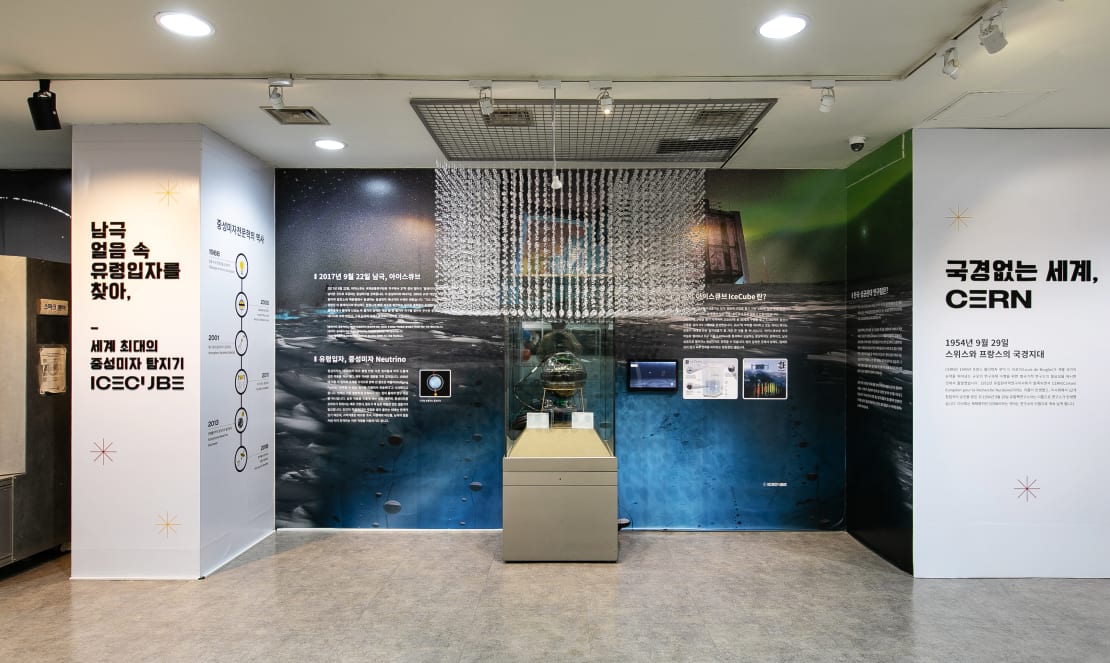
A new art–science exhibition at the Hanyang University Museum in Seoul, South Korea, features the IceCube Neutrino Observatory.
The exhibit, titled “The Cosmonaut,” is the creation of Dr. Michael Hoch, a scientist, artist, and educationalist with CERN’s CMS experiment who founded the art@CMS and ORIGIN programs “to foster cross-disciplinary science education engagement and networking with the aim to promote productive dialogues between the science, art and education communities.” ORIGIN is a consortium of international science collaborations that includes LHC experiments at CERN, gravitational wave collaborations LIGO and VIRGO, and IceCube.
Hoch was connected to IceCube through another artist with IceCube associations, York University professor Mark-David Hosale. When Hoch met Jim Madsen, IceCube’s associate director of education and outreach, they discussed Hoch’s upcoming projects, including one in Korea; after curating an exhibit about art and particle physics at the Institute for Basic Science (IBS) in Daejeon, Korea, in 2019, Hoch had been invited to bring a similar exhibition—enhanced with scientific topics of all ORIGIN partners active in Korea—to the Hanyang University Museum in Seoul.
So Madsen introduced Hoch to the leader of Korea’s only IceCube group, Carsten Rott. A physics professor at Sungkyunkwan University (SKKU), Rott worked with Hoch and the museum team to define the scope of the exhibit and discuss how they could give it a “personal touch” to connect the displays with the IceCube science being done in Korea.
Rott and his IceCube group ended up lending the exhibit SKKU’s digital optical module (DOM)—the main instrument of IceCube that can detect photons produced by neutrino interactions. They also provided one of the 700 camera systems that are being produced and tested at SKKU; this novel camera-based calibration system developed by Rott and his team is being integrated into all optical modules that will be used in an upcoming upgrade to IceCube. Woosik Kang (IceCube graduate student at SKKU) and Koun Choi (former IceCube postdoc at SKKU, now a research fellow at the IBS Center for Underground Physics) provided Korean text for the displays and highlighted Korean contributions to help facilitate a better connection for local students.
“It was quite impressive for me while I was preparing the exhibition because the displayed items (DOM and camera systems) have been installed in the South Pole for real or are going to be installed for the IceCube Upgrade,” said Jinkyong Lee, an administrative assistant from Rott’s group at SKKU who supported administrative work for the exhibition. “It is inspiring and educational to students and ordinary people who are interested in the universe but are not professional researchers. So I was very glad to prepare the exhibition with our group members, and hopefully it will be meaningful for young scientists in Korea getting familiar with IceCube research.”

“The Cosmonaut” was supposed to open in spring 2020 but was delayed (twice) because of COVID. It finally opened on May 20, 2021, though the museum still must comply with local COVID safety restrictions, which means fewer and smaller groups are allowed to view it at once. However, it features a novel online education program that is accessible worldwide, designed to extend its impact beyond the restrictions of the pandemic.
The exhibition will be on display at Hanyang University Museum until October 30, 2021. You can read more about the IceCube portion on the exhibit’s website.
Rott, who recently moved to the University of Utah in the United States but maintains his affiliation with SKKU, was unable to visit the exhibit himself due to COVID restrictions. However, Rott is happy to see the success of the exhibit so far. “It was exciting to receive pictures from the organizers and hear about the student groups enjoying the exhibition,” he said. “I was also very proud of my student Woosik addressing the audience at the opening ceremony and explaining IceCube science to them. As I am now mostly at the University of Utah, it was also great to see that my team in Korea worked so well together to make this event happen.”

“It was a great pleasure to prepare the exhibition and stand in front of the audience in the opening ceremony of the event with the invitation,” said Woosik Kang. “We had wanted to deliver a good impression and inspiration from the IceCube science programs and deliberated what would be needed to achieve this goal. At the ceremony, I could recognize that our efforts made a substantial contribution to the public by seeing and talking with the people who were expressing their curiosity and interest in the IceCube science.”
Hoch said that he hopes the success of this exhibition will motivate other ORIGIN partners to use this methodology and invite others to participate in similar projects. “‘The Cosmonaut’ exhibition and its cross-disciplinary science and art education program organized by all participating ORIGIN partners is once again an impressive example of how large international science collaborations engage together to inspire the next generation on various fundamental topics about the origin of the universe,” said Hoch.
Close-up of part of the the IceCube exhibit at the Hanyang University Museum in Seoul, Korea. Video courtesy of the Hanyang Museum.